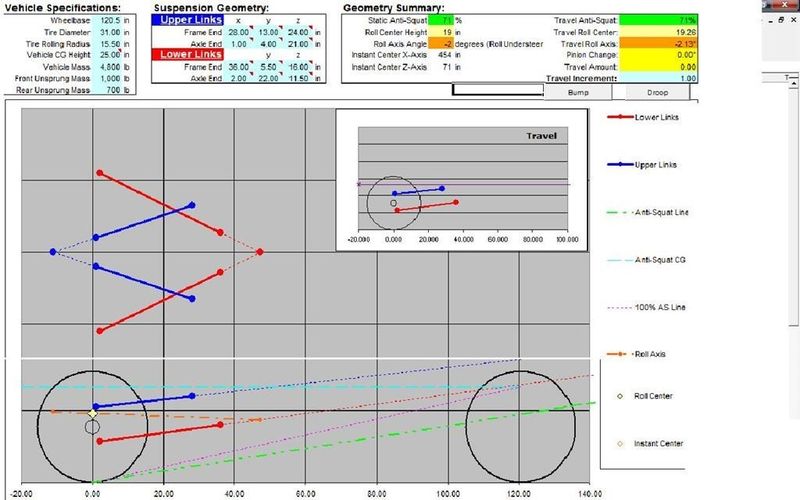F
Anti Squat and Roll Axis.
J
johnnywalker
+1y
Howdy, I plan on doing a bagged truck soon, which will be my first venture out of the rockcrawling world as far as link suspensions go.
My question is what are acceptable values for Anti Squat and Roll Axis at ride height?
Ive done some in the past where I did a double triangulated 4link with the roll axis sloping down just a bit and they seemed to behave better at higher speeds comapred to the others.
Thanks for any helpful replies.
My question is what are acceptable values for Anti Squat and Roll Axis at ride height?
Ive done some in the past where I did a double triangulated 4link with the roll axis sloping down just a bit and they seemed to behave better at higher speeds comapred to the others.
Thanks for any helpful replies.

BioMax
+1y
Rock crawlers have horrible high speed road manors because the roll steer is thown way south just to have ground clearence with good travel, so your sloping roll axis can be a good way to keep roll steer to a minimum. On a street driven minitruck, the roll axis is not much of a concern because the travel is only about 10" and an adjustable suspension should have fairly muted geometry to keep things useable at all points of travel and with that said, anti squat will also be minimal. If you want to push the envelope of air ride performance, you should limit travel and then you can push geometry a bit further. I would love to see what you have in mind.
J
johnnywalker
+1y
Edited: 1/5/2010 8:03:44 PM by johnnywalker
Thanks for the info. After measuring my workspace I came up with a rough design which should fit under the truck. Everything is based on a frame right height of 5" off the ground. The instant center is way out front, which from what I have read is fine for a street driven truck and shouldn't affect anything majorly. It incorporates that slight forward roll axis slope of -2* which I think should be plenty to help the truck in noticable cornering advantages. My questions are, 1.Do you think that the roll axis slope is fine? 2. In the "Geometry Summary" box are the numbers in the acceptable range for a street driven truck? Sorry for the picture being blurry. Thanks for any replies.
Thanks for the info. After measuring my workspace I came up with a rough design which should fit under the truck. Everything is based on a frame right height of 5" off the ground. The instant center is way out front, which from what I have read is fine for a street driven truck and shouldn't affect anything majorly. It incorporates that slight forward roll axis slope of -2* which I think should be plenty to help the truck in noticable cornering advantages. My questions are, 1.Do you think that the roll axis slope is fine? 2. In the "Geometry Summary" box are the numbers in the acceptable range for a street driven truck? Sorry for the picture being blurry. Thanks for any replies.


BioMax
+1y
From what I can tell, it looks like what you have calculated should work fine. There really aren't any difinitiave numbers for the questions that you are asking, but I think that whar you have could work well.
Related Discussions in Ask A Pro
Thread
Posts
Last Post
0
T
last post by
twistedmetal2188 +1y
4
H
last post by
himynameischance +1y

